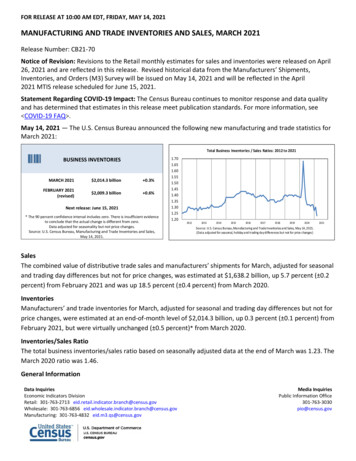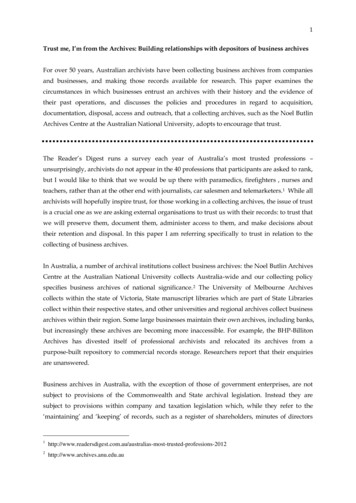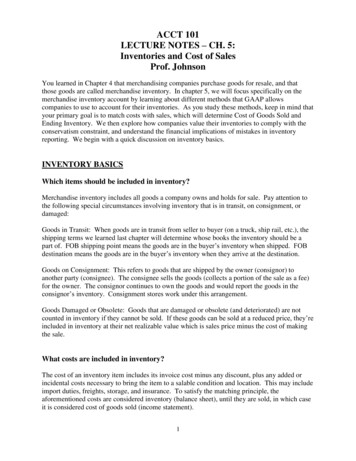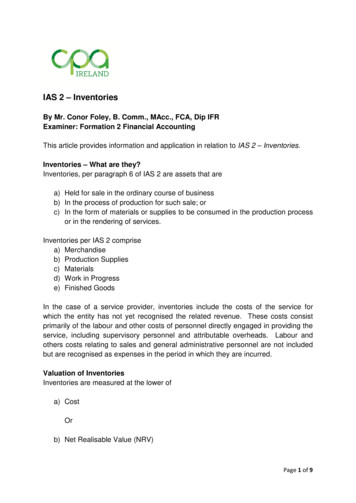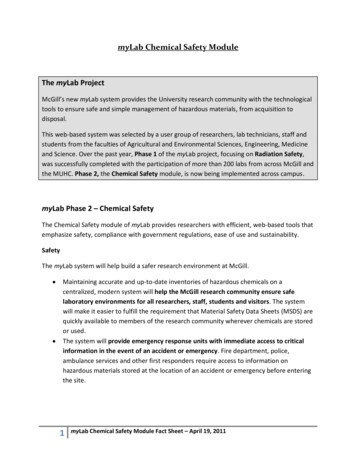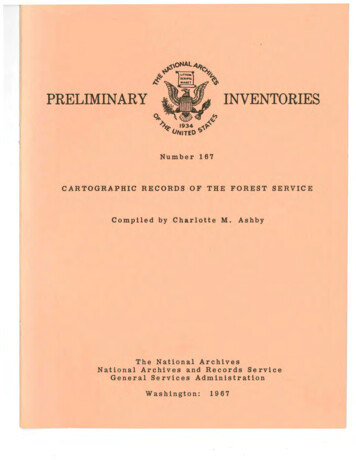
Transcription
INVENTORIESPRELIMINARYNumber 167CARTOGRAPHIC RECORDS OF THE FOREST SERVICECompiled by Charlotte M. AshbyThe National ArchivesNational Archives and Records ServiceGeneral Services AdministrationWashington:1967
PRELIMINARY INVENTORY OF THE CARTOGRAPHICRECORDS OF THE FOREST SERVICE(Record Group 95)Compiled by Charlotte M. AshbyThe National ArchivesNational Archives and Records ServiceGeneral Services AdministrationWashington:1967
National Archives Publication No. 67-5Library of Congress Catalog Card No. A67-7213
FOREWORDGSA through the National Archives and Records Serviceis responsible for administering the permanent noncurrentrecords of the Federal Government. These archival holdings, now amounting to about 900,000 cubic feet, date fromthe days of the Continental Congresses; they include thebasic records of the three branches of our Government-Congress, the courts, and the executive departments andindependent agencies. The Presidential Libraries . - Hoover,Roosevelt, Truman, and Eisenhower--contain the papers ofthose Presidents and many of their associates in office.Among our holdings are many hallowed documents relatingto great events of our Nation's history, preserved and venerated as symbols to stimulate a worthy patriotism in all ofus. But most of the records are less dramatic, kept becauseof their continuing practical utility for the ordinary processes of government, for the protection of private rights,and for the research use of students and scholars.To facilitate the use of the records and to describe theirnature and content, our archivists prepare various kinds offinding aids. The present work is one suchpublication. Webelieve that it will prove valuable to anyone who wishes touse the records it describes.LAWSON B. KNOTT, JR.Administrator of General Servicesiii
PREFACEThe first step in the records-description program of theNational Archives is the compilation of preliminary inventories of the material in some 380 record groups to which theholdings of the National Archives are allocated. These inventories are called "preliminary" because they are provisional in character. They are prepared as soon as possibleafter the records are received without waiting to screen outall disposable material or to perfect the arrangement of therecords. They are compiled primarily for internal use, bothas finding aids to help the staff render efficient referenceservice and as a means of establishing administrative control over the records.Each preliminary inventory contains an introduction thatbriefly states the history and functions of the agency thataccumulated the records. The. records themselves are described series by series; that is, by units of records of thesame form or that deal with the same subject or activity orthat are arranged serially. Other significant informationabout the records may sometimes be given in appendixes.Several finding aids that give an overall picture of materials in the·National Archives have been published. A com prehensive Guide to the Records in the National Archives(1948) and a brief guide, Your Government's Records in theNational Archives (revised 1950), have been issued. A guidedevoted to one geographical area--Guide to Materials on LatinAmerica in the National Archives (1961)--has been published.Forty-four Reference Information Papers, which analyze records in the National Archives on such subjects as transportation, small business, and the Middle East, have so far beenissued. Records of the Civil War have been described inGuide to Federal Archives Relating to the Civil War (1962)v
and Civil War Maps in the National Archives (1964}, thoseof World War I in Handbook of Federal World War Agenciesand Their Records, 1917-1921 (1943), and those of WorldWar II in the two-volume guide, Federal Records of WorldWa:r II (1950-51). Genealogical records have been listed IiiGuide to Genealogical Records in the National Archives (1964).Many bodies of records of high research value have been edited by the National Archives and reproduced on microfilmas a form of publication. Positive prints of this microfilm,many of which are described in the List of National ArchivesMicrofilm Publications. (19.66), a:re available for purchase.ROBERT H. BAHMERArchivist of the United Statesvi
CONTENTSPageIntroduction . . .1.Inventory . . . . . . . . . . . . .General cartographic records . . . . . .Records of the Office of the Chief . . . Records of the Division of Fiscal Control . . . . . . . .Records of the Division of Operation . . . .Records of the Northeastern Timber Salvage Administration Records of national forests divisions . . . . . . . . . Records of the Division of Engineering . . . . . . .Records of the Division of Timber Management . . . . .Records of the Division of Range Management . . . . . .Records of the Division of Recreation and LandsRecords of the National Forest Planning and EstablishmentDi'Vision. . . . . . . . . . . . . . . .Records relating to forest research . . . . . Records of the Division of Forest Products . . . .Records of the Division of Range Research . .Records of the Division of SUvics . . . . . Records of Forest and Range Experiment StationsRecords of State and private forestry divisions . . .Records relating to Civilian Conservation Corps work3399991010121317. . . .17. .22222223232526. . . . .Appendix:Description of records in the project files of the Drafting andAtlas Section, Division of Engineering (entry 94) .27Index . . . . . . . . . . . . . . . . . . . . . . . . . . . . . . .35vii
INTRODUCTIONThe development of the Forest Service datesfrom 1876, when the Commissioner of Agriculture was authorized to appoint a special agentto study general forest conditions in the UnitedStates (19 Stat. 167). In 1881 a Division of Forestry was established in the Department of Agriculture to function primarily as an investigative and information agency. In 1901 this Divisionbecame the Bureau of Forestry (31 Stat. 929),and in 1905 it was renamed the Forest Service.The General Land Office! of the Departmentof the Interior was responsible for administering forest reserves from 1881, when Congressfirst authorized the establishment of Federalforest reservations from timberlands on thepublic domain, to 1905, when this function wastransferred to the Forest Service; in 1907 forest reserves were redesignated national forests.The internal organization of the Service isbased on functions that may be summarized asmanagement of national forests and grasslands,cooperation with State agencies and privateowners, and research. While organizationaldivisions have increased in number and haveundergone frequent name changes since theService was established and although activitiesand responsibilities have broadened, these threebasic functions have remained. Because mostof the map records pertain to the period 1920-40,they are arranged and described according to thedivisional pattern that existed toward the end ofthis period. The following organization, .basedon the 1938 directory of the Forest Servic;e, wasused in identifying and describing these records:Chief's Office DivisionsDivision of Fiscal ControlAdministrative Management and Information GroupDivision of OperationDivision of Personnel ManagementDivision of Information and Education1some maps of forest reserves dated before1905 are among the records of the General LandOffice. See National Archives Special List 19,List of Cartographic Records of the GeneralLand Office, compiled by Laura E. Kelsay in1964.National Forests DivisionsDivision of Fire ControlDivision of Timber ManagementDivision of Range ManagementDivision of Wildlife ManagementDivision of Recreation and LandsDivision of EngineeringLand Acquisition GroupDivision of National Forest Planningand EstablishmentDivision of Land AcquisitionState and Private ForestryDivision of Private ForestryDivision. of ·state CooperationForest Research DivisionsDivision of SilvicsDivision of Range ResearchDivision of Forest ProductsDivision of Forest ·EconomicsDivision of Forest InfluencesCivilian Conservation Corps GroupCoordinating DivisionCamp Programs DivisionEnrollee Training Division. The map records not identified with a specificdivision or office are included under the headingGeneral Cartographic Records.At the present time most of the work of theForest Service is decentralized in nine regionaloffices. The Washington or central office divisions supervise the regional activities andprovide leadership and direction. The Divisionof Engineering,· listed as one of the nationalforests divisions, is responsible for the basicmapping programs of the Service and producestopographic, planimetric, and special maps ofthe areas administered by the Ser vice. Themapping standards of the Division conform tothose of the U.S. Geological Survey and, toprevent duplication, the Forest Service mapsonly those areas under its supervision that havenot been mapped by the Geological Survey.Since about 1935 aerial photography has beenused extensively in mapping. The aerial photographic flights are contracted by the Service toprivate concerns, and the photographs are usedfor fire-control purposes and for range andtimber surveys.1
2INTRODUCTIONAlthough the other Forest Service divisionshave not as a general rule been responsible forbasic mapping activities, they have used mapsas a means of presenting information and asworking tools. The map records of these divisions usually consist of base maps, preparedeither by the Division of Engineering or byother Government agencies, annotated to showselected information. These map records aremore extensive than those of the Division ofEngineering and include valuable informationabout land use, land classification and management, and other research, management, andplanning activities of the Forest Service. Themaps prepared during the 1930's, when theForest Service was cooperating with the otherGovernment agencies to improve the country'seconomic position, provide much informationabout rural economic conditions.Most of the maps were prepared in theregional offices at the request of the centraloffice divisions. The directives for the mapswere so precise that, in spite of their beingprepared in several offices, the maps are generally uniform in appearance and manner ofpres entation.The records described in this inventory arethe map files of the Forest Service that were inthe National Archives on September 22, 1966.22Early aerial photographic surveys of theService, dated from 1934 to 1938, were accessioned by the National Archives after September 22, 1966, and are not described in thisinventory.They are part of Record Group 95, Records ofthe Forest Service, and amount to 255 cubicfeet. There are 14, 737 discrete items (reports,atlases, and individual maps). The textualrecords of the Forest Service have been described in the National Archives' PreliminaryInventory No. 18, Records of the Forest Service (Washington, 1949).-An index to the records described in eachentry is included in this inventory. Since manyof the entries do not specify all the maps byarea, name of national forest or other administrative area, or subject, the index has beendesigned to provide this information. Namesof national forests have been indexed, but noattempt has been made to bring these maps upto date with the continuing name and boundarychanges that have occurred since the forestswere first established. The index provides thename of the forest appearing on the discretemap record. Many of the index entries referto series 94, which consists of the project filesof the Drafting and Atlas Section of the Divisionof Engineering. The records in this series relate to many subjects and areas. The individualcontents of the folders in the series are describedin the appendix. The index entries for this seriesuse a letter-number designation that refers tofolder files, as listed in the appendix.
GENERAL CARTOGRAPHIC RECORDSThe general cartographic records describedbelow belong to a mass of records that weretransferred from the Forest Service withoutidentification as to their origin within the organizational framework of that agency. Theyhave been arranged and are described in seriesaccording to subject matter.1. MAP OF THE UNITED STATES SHOWINGTHE FIELD ORGANIZATION OF THEFOREST SERVICE AND THE PRINCIPALAGENCIES COOPERATING WITH THESERVICE. ca. 1939. 1 item.A base map, dated 1939; annotated to showregional boundaries and state and regional headquarters offices of the Forest Service, theNational Resources Planning Board, the SoilConservation Service, and the Farm SecurityAdministration. Also shown are the headquarters offices of State foresters and locationsof State agricultural colleges.2. MAPS OF THE UNITED STATES ANDPARTS THEREOF SHOWING NATIONALFORESTS. 1908-55. 35 items.Published maps of the United States showinglocations of national forests, Forest Servicedistricts or regions and regional headquarters,and forest products laboratories; some editionsalso show State forests, Indian reservations,Bureau of Reclamation project areas, nationalparks and monuments, and Forest Service purchase areas and those areas in which purchaseswere to be authorized by special acts of Congress; and one edition, dated 1908, also showsthe amount of lumber cut in each region in 1906.There are also published maps of the EasternUnited States showing national forests, purchaseareas, and shelterbelt areas in 1935 and national forests, purchase units, and the PrairieStates Forestry Project in 1938 and 1939. Arranged chronologically.3. PRESIDENTIAL PROCLAMATIONS, EXECUTIVE ORDERS, AND MAPS RELATINGTO THE ESTABLISHMENT OF ANDCHANGES IN FOREST RESERVES ANDNATIONAL FORESTS. 1891-1935. ca.1, 350 items.A two-part series. The first part consistsof bound volumes of printed proclamations ororders dated from 1891 to March 1, 1907, arranged chronologically. The proclamations andorders dated from 1891 to October 3, 1905, areaccompanied by printed base maps annotated toshow boundaries of the forest as established byor changed by the proclamations or orders, andthose dated after October 3, 1905, are accompanied by printed maps incorporated with thedocuments. The second part of the series consists chiefly of printed documents and relatedmaps dated since March 2, 1907, which are arranged alphabetically by name of national forestand thereunder chronologically by date of document. A few proclamations and maps relatingto national parks are included.4. MAPS OF NATIONAL FORESTS ILLUSTRATING WITHDRAWALS AS AUTHORIZEDBY EXECUTIVE ORDERS. 1914-22.16 items.Annotated. 5. MAP OF THE UNITED STATES SHOWINGCOMPARATIVE AREAS OF NATIONALFORESTS. 1937. 1 item.A manuscript diagrammatic map.6. MAPS OF THE UNITED STATES SHOWINGRECOMMENDATIONS FOR NATIONALFORESTS. 1935 and 1942. ?. items.A published map, dated 1935, showingpresent and recommended national forests anda map annotated to show eliminations from andaccretions to national forests as recommended3
4CARTOGRAPIITC RECORDS OF THE FOREST SERVICEby the National Forest Resources Committeein 1942.7. MAPS AND GRAPHS SHOWING PRESENTAND RECOMMENDED OWNERSIITP, USE,AND MANAGEMENT OF FOREST LANDIN THE UNITED STATES. n. d . . 6 items.Printed maps showing the existing dominantownership and dominant intensity of management of forest lands and that recommended bythe Forest Service. The graphs show, bystate, existing ownership and recommendeduse of forest lands.8. "OLD STATISTICAL DIAGRAMS 1908 to1913 [1919]." 1 item.A bound volume of 57 maps, charts, andtables containing the following information aboutnational forests: the annual costs for administering each, the number of permits issued forspecial uses of forest lands, settlements bykind, receipts from uses and settlements,damages caused by forest fires, distribution ofcommercial trees and the amount and value ofcut lumber, kinds of employment. on forestlands, trespassers, and the dates of establishment of each forest.9. MAPS SHOWING SELECTIONS FOR THEMINNESOTA FOREST RESERVE. 1903.3 items.Manuscript maps consisting of two versionsof a map showing first selections for the forestreserve and a map showing lands withdrawnpending final selections for the reserve. Thesemaps were compiled in the Bureau of Forestryof the Department of Agriculture.10. MISCELLANEOUS MAPS OF NATIONALFORESTS SHOWING CHANGES AND RECOMMENDED CHANGES. 1908-37.15 items.A map of the Ashley National Forest, utahand Wyq., annotated to show additions in 1931;a map of the Clearwater National Forest, Idaho,annotated to show lands added by the abandonment of the Selway National Forest, lands transferred from the st. Joe National Forest to theClearwater National Forest, and lands transferred from the Clearwater to the Lolo NationalForest, 1931-35; a map annotated to show proposed additions· to the Columbia National Forest,Wash., 1937; a map of the Dixie National Forest, Utah arid Nev., showing lands recommendedfor purchase, ca. 1933; a map annotated toshow the division of the Gila Forest Reserve,N. Mex. , into the Datil and Gila National Forests; a map annotated to show a boundary adjustment to the Grand Mesa National Forest,Colo., ca. 1922; a map of the Francis MarionNational Forest, S.C., annotated to show boundary changes, 1936; a map of the Idaho NationalForest, Idaho, annotated to show eliminatedlands, 1940; a map of the Kaibab National Forest, Ariz. , annotated to show lands eliminatedfor the Grand Canyon National Park, 1919; amap of the Olympic National Forest, Wash.,annotated to show public domain, areas offeredunder the exchange act of 1922, and acceptedareas; a map of the Kaniksu National Forest,Idaho, annotated to show the new boundary andexcluded areas, 1922; a map of the -Ozark National Forest, Ark., annotated to show nonGovernment lands; a map of the Santa Fe National Forest, N. Mex. , . annotated to showresettlement areas transferred to the nationalforest and lands added to Grazing District 1; amap of the Sierra National Forest, Calif., annotated to show the new boundary and areascovered by sales contracts, ca. 1927; and amap of the Sioux National Forest, S. Dak. andMont., annotated to show eliminations, ca. 1919.Arranged alphabetically by name of forest.11. MAPS SHOWING WILDERNESS AND WILDAREAS. 1928-61. 6 items.Printed maps of the Western United Statesand Minnesota, one dated 1947 and the otherundated, showing wilderness and wild areas.National forests and purchase units are alsoshown on the 1947 map. There is also a basemap of California annotated in 1928 to showwilderness areas and national forests, parks,and monuments.12. MAP OF THE UNITED STATES SHOWINGTHE MOST CRITICAL WATERSHED,EROSION, AND SUBMARGINAL AREAS INNATIONAL FORESTS. n. d. 1 item.Photoprocessed.13. MAP OF THE UNITED STATES SHOWINGTHE RELATIVE INFLUENCE OF FORESTSON WATERSHED PROTECTION. n. d.1 item.Published.14. LAND CLASSIFICATION MAPS. 1908-49.22 items.Three versions, two manuscripts and one
GENERALpublished, of a map of North America, ca. 1908,showing absolute forest, agricultural, grazing,and barren lands; a panel of maps of the UnitedStates showing national forests in 1895, 1900,1905, 1910, 1915, and 1940, prepared for astudy of forest land classification; maps ofparts of the Western United States annotated inthe Forest Service regional offices in 1913 foruse in the "Public Use . . . [and] Red Book[s],"showing commercial timber areas, woodlands,and agricultural, grazing,. and barren lands;base maps of Alabama, Maine, Utah, and apart of the Lewis and Clark National Forest prepared for the forest land classification studiesand copies of these base maps annotated incolors to show forest land classification data;a map of part of Indiana in Morgan, Perry,Clark, and Pike Counties annotated to showagricultural areas and areas in which 75 percent or more of the land is better suited to forestry than agriculture; and a base map for aforest land classification study of the Pike National Forest, Colo. Arranged by area.15. MAPS SHOWING QUADRANGLE NAMESAND TRIANGULATION STATIONS. 1911.36 items.Photoprocessed copies of Post Office mapsof States and groups of States that had been previously annotated to show quadrangle names,triangulation stations, primary traverse lines,and level routes. Arranged numerically bymap number and accompanied by a map of theUnited States on which the map numbers areindexed by coverage.16. MAPS OF THE NORTH-CENTRAl:. ANDNORTHWESTERN UNITED STATES SHOWING THE DEVELOPMENT OF TERRITORIAL AND STATE BOUNDARIES. n. d.4 items.Base maps of parts of the United Statesannotated to show boundaries as described inHenry Gannett, Boundaries of the United States(3d ed. ; U.S. Geological Survey Bulletin 226,Washington, 1904).17. ISOGONIC MAPS OF THE UNITED STATESAND CANADA. 1950-51. 2 items.Manuscript maps. The map of the UnitedStates was prepared by the U. S. Coast andGeodetic Survey; that of Canada, by the CanadianDepartment" of Mines and Resou·rces.18. MAPS OF THE EASTERN UNITED STATESSHOWING RAILROADS AND CANALS, 18401915. 1922. 1 item.A panel of four manuscript maps showing5railroads in operation in 1840, 1850, and 1860;and the canals and principal canalized riversabandoned before 1915 and those in use in 1915.Names of railroads and canals are listed andkeyed by number to the proper location on eachmap.19. STATE MAPS SHOWING NATIONAL FORESTS. 1930-39. 19 items.Printed maps, dated 1930-39, and onemanuscript map without date. Arranged alphabetically by name of State.20. MAPS SHOWING BOUNDARIES AND PROPOSED BOUNDARIES OF NATIONALPARKS AND MONUMENTS. ca. 1911-39.18 items.A map of Sequoia National Park, Calif.,ca. 1911, annotated to show the boundary extension proposed by the Sierra Club, park administrative sites, easements, rights-of-way,patented and pending lands, timber and mineralentries, State selections, and reconveyances; amap of the stanislaus National Forest, Calif.,1924, showing locations of big trees and annotated to show proposed park boundaries aridplans of townships within the forest showingnumber and kind of trees within quarter sections; a map of Kentucky ·annotated to showcounties to be included in the Breaks of San.dyNational Park, 1939; an undated map annotatedto show boundary changes in the Boulder DamRecreation Area, Ariz. -Nev.; an undated map .annotated to show proposed timber additions tothe Grand Canyon National Park, Ariz., mapsshowing boundary changes in the Colonial National Monument, Va., 1952, the Scotts BluffNational Mmiument, Nebr., 1949, and theChiricahua National Monument, Ariz., 1938; amap annotated to show the established boundariesof the Mammoth Cave National Pa: k, Ky. , ca.1933; and an undated map annotated to show theapproximate boundary of the Big Bend StatePark, Tex. Arranged alphabetically by area.21. MAPS SHOWING CONFLICT BETWEENPROPOSED BOUNDARY OF GREAT SMOKYNATIONAL PARK AND THE CHEROKEENATIONAL FOREST, TENN. 1940.3 items.Topographic quadrangles covering the areaof conflict annotated to show the boundaries ofthe park and the forest as described in the respective proclamations, the boundary of theproposed enlargement of the park, and areas ofconflict with the national forest.
6CARTOGRAPIITC RECORDS OF THE FOREST SERVICE22. MAP OF THE UNITED STATES SHOWINGTHE ACREAGE OF STATE-OWNED FORESTS AND PARKS. 1930. 1 item.A manuscript map. Information is givenby State.23. MAPS SHOWING FOREST REGIONS ANDTHE DISTRIBUTION OF INDIVIDUALSPECIES OF TREES. 1910-48. 23 items.One published and one annotated map ofthe United States showing forested areas, published maps of the United States showing originaltimber regions and forests by major tree species,and published maps of States and parts of Statesshowing major tree species. Arranged by area.24. MAPS OF THE UNITED STATES SHOWINGINFORMATION ABOUT COMMERCIALTIMBER. 1915-27. 17 items.Published maps consisting of a map, dated1915, showing graphically by State the amountand major kind of timber available; a map, dated1916, showing by State the distribution of principal commercial species of trees; a map, dated1916, showing by region the relation of lumbercut and mill capacities to standing timber; maps,·dated 1926 and 1927, showing headquarters ofprincipal softwood lumber manufacturers' associations and woods in which grading rulesapplied, with tables giving information aboutcomparable grades of lumber products; an undated photoprocessed map showing national forests by State with annotations to show ownershipof commercial forest lands and the applicationof reasonably good private forest practices; anda series of 11 base maps of the United States,annotated to show by county and by kind of treethe amount of lumber cut in 1917.25. MAPS AND GRAPHS RELATING TO FOREST REGIONS AND WOOD PRODUCTIONIN THE WORLD. 1909-44. 35 items.Published maps showing forest regions ofthe world and of Africa, Asia and parts of Asia,Australasia, Canada and Newfoundland, Europeand parts of Europe, and parts of Latin America,including the Caribbean area; a world map annotated to show important timber trees; undatedmaps of the world showing virgin shelter forestsand rubber plantations by kind of tree; manuscript worksheets, several of which were compiled by Raphael Zon in 1922, showing forestregions by kind in Europe, Central Europe, andPoland; and statistical graphs showing forestacreage and production of forest resources bycountry. Some of the graphs were preparedduring World War I and show forest acreage andlumber production of the Allied Powers, CentralPowers, and neutral countries.26. MAPS SHOWING PAPERMILLS, PULPMILLS, AND BOARD MILLS. 1915-37.16 items.Manuscript maps of the world, of individualcontinents, and of the United States showing papermills and pulpmills, 1917-22; a photoprocessedmap, compiled in 1915 by the New England Paperand Pulp Traffic Association, showing papermills and board mills of the Eastern UnitedStates and Canada and the productive capacity ofeach; manuscript maps of the United States, 1917,showing sulphate, sulphite soda, and ground-woodpulpmills; and a manuscript map of the Southeastern United States, 1937, showing locationsof papermills and pulpmills using wood as rawmaterial.27. MAP OF THE UNITED STATES SHOWINGBY STATE SOME CONIFEROUS TREES.SUITABLE FOR PLANTING ON FARMS.1924. 1 item.Manuscript.28. MAPS OF WISCONSIN AND MINNESOTASHOWING TIMBER-USING INDUSTRIES.1915. 2 items.Manuscript.29. MAPS OF TEXAS SHOWING LIFE ZONES,VEGETATION, RAINFALL REGIONS,NATURAL REGIONS, AND THE DISTRIBUTION OF DIFFERENT SPECIES OFTREES. n. d. 4 items.Two panels, with a total of nine publishedmaps, and two separate published maps.30. MAPS OF THE UNITED STATES SHOWINGDATA FROM ECONOMIC STUDIES OFRURAL AND FOREST LANDS. 1929-35.39 items.Manuscript and annotated maps showingrural population and forest lands in relation tototal population, farm income, and expenditures;number of persons engaged in farming; percentof population receiving relief; increase or decrease in farmlands and migration of farm families; and submarginal farmlands, recommendations for use, and -long-range plans for reforestingsome of these lands.31. ILLUSTRATIONS RELATING TO FARM ANDCOMMUNITY DEVELOPMENT. n. d.12 items.Diagrams relating to general methods offarm and community development and maps showing the Koochiching Project, Minn., the Duluth &
GENERALIron Range Railroad grant, St. Louis County,Minn., and the Vallee Settlement, Rusk County,Wis.32. MAPS AND RELATED RECORDS PERTAINING TO ECONOMIC STUDIES OF THELAKE STATES. 1940. 25 items.Manuscript maps, including a map of Minnesota, Wisconsin, and Michigan, showingnational, county and State forests, Indian lands,and CCC camps by agency of control; a map ofthe United States showing graphically the important features that characterized the positionof the three Lake States in the national economy;a series of maps showing rural-industrial andrural-agricultural counties in the three States,counties with more than 50 percent of lands infarms, concentrations of publicly owned lands,idle lands that could be restored by reforestation, the percentage of unemployment, the percentage of farms with gross income under 600,the distribution and condition of major forestlands, the development of farms since 1860,private lands of more than 50,000 acres, majorkinds of employment in urban centers, population distribution, distribution and density of thefarm areas, important physical limitations,·pattern of forest economy based on proportionof workers in forest industries, pattern ·ofLake States economy based on proportion ofgainfully employed workers in important basicindustries, the trade network of the area, taxdelinquent lands, principal outdoor recreationareas, and mineral resources; a chart showingthe number of men gainfully employed in ruralindustrial and rural-agricultural sections; anda title sheet for the series.33. MAPS AND A GRAPH PERTAINING TOSTUDIES OF LAND USE IN DORCHESTERTOWNSHIP, N.H. 1934. 7 items.Manuscript maps compiled from studiesmade by Harry C. Woodworth in associationwith the New Hampshire Agricultural Experiment Station of the University of New Hampshire,including a location map and maps showing landownership, forest types, ages of forests, soilssuitable for crops, and the decline of farmingsince 1860, and a graph showing the rehabilitation plan for the development and improvementof forests.34. MAP OF THE CHIPPEWA NATIONAL FOREST, MINN., SHOWING RECOMMENDEDLAND USE. 1935. 1 item.Shows ar'e as recommended by local peoplefor permanent communities, recreation, Indians,wildlife, and multiple-use forestry purposes.7Included is an inset enlargement of the town ofRemer and vicinity showing the families livinginside the Remer farming area and those livingoutside the area, national forest lands to beused as trading stock with families living outside the Remer farming area, and national forest lands outside the area.35. MAPS FROM STUDIES
Enrollee Training Division . The map records not identified with a specific division or office are included under the heading General Cartographic Records. At the present time most of the work of the Forest Service is decentralized in nine regional offices. The Washington or central office di visions supervise the regional activities and
